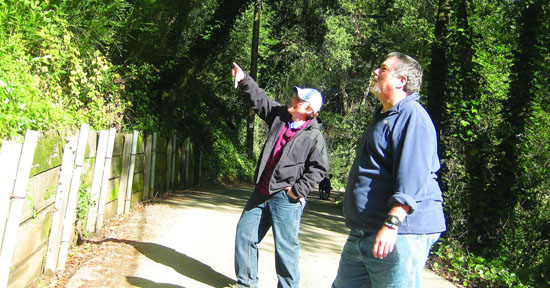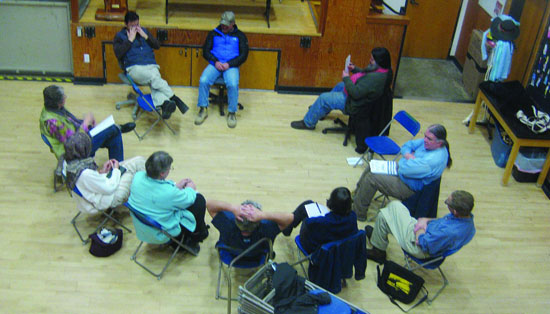 | | | Sean Swanson, left, and his brother Orion hold up the disaster preparedness signs they have ready to post outside their house in the aftermath of an emergency. The signs are provided through the fire department with a grant from the U.S. Department of Homeland Security. Photo Chris Lavin | | | | | | Nine-year-old Sean Swanson of Canyon has it down. What would he do if a wildfire was suddenly sweeping up the canyon?
 "Take the important documents," he said firmly, "and go to the staging area." He is asked if he knows what important documents are, or where they are kept. His mother breaks into his detailed response regarding exactly what, exactly where.
"Take the important documents," he said firmly, "and go to the staging area." He is asked if he knows what important documents are, or where they are kept. His mother breaks into his detailed response regarding exactly what, exactly where.
 "We've talked this. We have meeting spots," says Sonya Wilson, mother to Sean and Orion. "We've practiced it." But then Sean broke in: "And then I would get the pictures, and my fish, and my mealworms. And watch after my brother."
"We've talked this. We have meeting spots," says Sonya Wilson, mother to Sean and Orion. "We've practiced it." But then Sean broke in: "And then I would get the pictures, and my fish, and my mealworms. And watch after my brother."
 "No," 6-year-old Orion replies. "I will look after you."
"No," 6-year-old Orion replies. "I will look after you."
 We are all told repeatedly that it's coming. "The Big One." Maybe a nearby fire, instead of an earthquake. We're overdue for the quake, and the dry weather has the worried among us looking at tinder-like brush piles beneath bay trees on slopes. Residents are told to prepare an earthquake kit, order pharmaceuticals ahead, make sure to have a flashlight and shoes by your bed. We've heard it all. And we're tired. We're either prepared or we're not. Most of us fall into the latter category.
We are all told repeatedly that it's coming. "The Big One." Maybe a nearby fire, instead of an earthquake. We're overdue for the quake, and the dry weather has the worried among us looking at tinder-like brush piles beneath bay trees on slopes. Residents are told to prepare an earthquake kit, order pharmaceuticals ahead, make sure to have a flashlight and shoes by your bed. We've heard it all. And we're tired. We're either prepared or we're not. Most of us fall into the latter category.
 According to the California Emergency Management Agency, fewer than 20 percent of Californians are prepared to last relatively comfortably for three days without power and water, although Northern California is slightly more prepared. The agency names "citizen preparedness" as the weakest link in the chain of disaster readiness. In the Lamorinda area, with its narrow, winding roads and remote neighborhoods, a big disaster will likely leave hundreds, if not thousands, of pockets inaccessible to emergency crews - and to public works crews able to clear felled trees, providing access to services and stores and hospitals.
According to the California Emergency Management Agency, fewer than 20 percent of Californians are prepared to last relatively comfortably for three days without power and water, although Northern California is slightly more prepared. The agency names "citizen preparedness" as the weakest link in the chain of disaster readiness. In the Lamorinda area, with its narrow, winding roads and remote neighborhoods, a big disaster will likely leave hundreds, if not thousands, of pockets inaccessible to emergency crews - and to public works crews able to clear felled trees, providing access to services and stores and hospitals.
 For it's when the ground settles, the work begins.
For it's when the ground settles, the work begins.
 "That's the scary part," said Jonathan Goodwin, the community appointed fire-and-disaster chief of the small community of Canyon, west of Moraga. "People don't think about what happens after." (See related story on page B2.)
"That's the scary part," said Jonathan Goodwin, the community appointed fire-and-disaster chief of the small community of Canyon, west of Moraga. "People don't think about what happens after." (See related story on page B2.)
 People in Canyon, as in other neighborhoods in Lamorinda, are thinking about those moments "after." The United States Geological Survey offers interactive maps (www.usgs.gov and search shakemaps) that show that Moraga, for instance, sits mainly on mud. "You can expect landslides and closed roads," Goodwin said.
People in Canyon, as in other neighborhoods in Lamorinda, are thinking about those moments "after." The United States Geological Survey offers interactive maps (www.usgs.gov and search shakemaps) that show that Moraga, for instance, sits mainly on mud. "You can expect landslides and closed roads," Goodwin said.
 Yet the key to getting through any disaster, he added, is to consider the concept of "reciprocal altruism." It is a concept that is widely accepted in biological fields, one in which organisms help each other to keep them all alive and healthy. Using in part an elaborate brochure funded by the U.S. Department of Homeland Security, called "Map Your Neighborhood," and available through the fire department, Canyon and other neighborhoods are beefing up their awareness of who lives where, who has pets, who might have an elderly relative, or who might have children home alone after school.
Yet the key to getting through any disaster, he added, is to consider the concept of "reciprocal altruism." It is a concept that is widely accepted in biological fields, one in which organisms help each other to keep them all alive and healthy. Using in part an elaborate brochure funded by the U.S. Department of Homeland Security, called "Map Your Neighborhood," and available through the fire department, Canyon and other neighborhoods are beefing up their awareness of who lives where, who has pets, who might have an elderly relative, or who might have children home alone after school.
 "Here in Canyon, we know most of that already," Goodwin said. But things change all the time, he added. Tenants change, people have babies, elderly parents move in or people become incapacitated.
"Here in Canyon, we know most of that already," Goodwin said. But things change all the time, he added. Tenants change, people have babies, elderly parents move in or people become incapacitated.
 The MYN brochure outlines nine steps to take after a disaster, and is intended for neighborhoods that are already organized or attempting to organize. Its first step: Look after your family, but then "reciprocal altruism" takes over. The idea is to be self-sustaining after any type of disaster. The brochure includes "Help" and "OK" signs to hang outside your house to let neighbors know your status.
The MYN brochure outlines nine steps to take after a disaster, and is intended for neighborhoods that are already organized or attempting to organize. Its first step: Look after your family, but then "reciprocal altruism" takes over. The idea is to be self-sustaining after any type of disaster. The brochure includes "Help" and "OK" signs to hang outside your house to let neighbors know your status.
 As the brochure says, "In a disaster, your neighbors are your closest sources of help."
As the brochure says, "In a disaster, your neighbors are your closest sources of help."
 People have different abilities," Goodwin said. Some people can look after children, some will know how to approach a collapsed structure, some will know CPR.
People have different abilities," Goodwin said. Some people can look after children, some will know how to approach a collapsed structure, some will know CPR.
 "That's the critical thing," Goodwin said. "If you have a person with a crushing injury, or someone with a heart attack, and emergency services can't get in, you need to know how to get that person out."
"That's the critical thing," Goodwin said. "If you have a person with a crushing injury, or someone with a heart attack, and emergency services can't get in, you need to know how to get that person out."
 In other words, one must know who has a chainsaw, or a four-wheel drive.
In other words, one must know who has a chainsaw, or a four-wheel drive.
 "It's a starting point," Goodwin says about the brochures. The next step is to get to know the neighbors, so that reciprocal altruism can take over when disaster strikes.
"It's a starting point," Goodwin says about the brochures. The next step is to get to know the neighbors, so that reciprocal altruism can take over when disaster strikes.
 "Everybody loves a potluck," Goodwin said. So maybe we should all plan to have one.
"Everybody loves a potluck," Goodwin said. So maybe we should all plan to have one.

|



